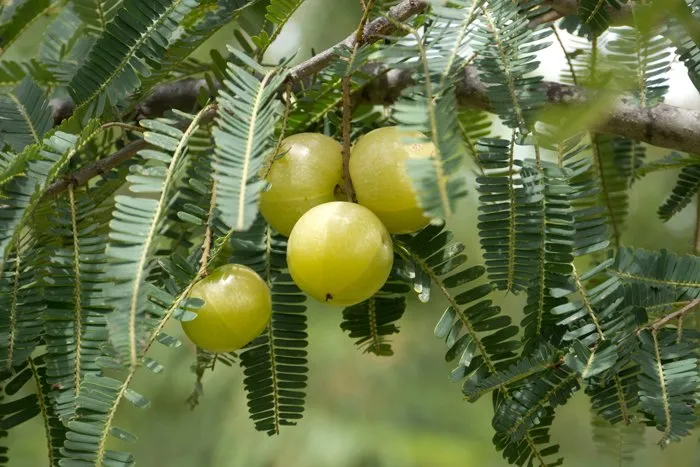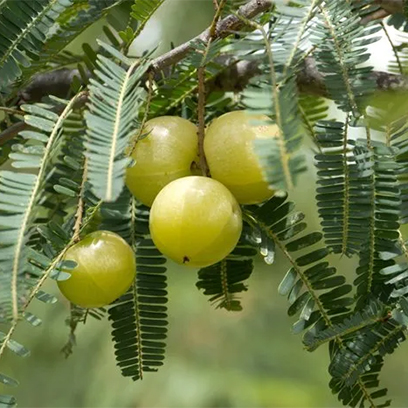On This Page
Amalaki (Emblica officinalis) – The Indian Gooseberry
Introduction
Amalaki botanically known as Emblica officinalis or Phyllanthus emblica is traditional food and medicine with many medical and nutritional benefits. Indian Gooseberry is commonly famous with the name Amla and is a powerful antioxidant and the richest natural source of Vitamin C. In Ayurvedic classical texts, Amalaki is considered the best herb for Parmeha (diabetes), Raktaja Vikara (bleeding disorder), Rasayana (Rejuvenator), and anti-aging herb. Acharaya Charaka “the father of medicine” considered Amalaki as Deepaniya, Pachaniya, Ayushya, etc. and in Agraya Aushada (best drugs) Amalaki is considered Agraya (best) for Vyasthapana Karma. Recent studies revealed various active chemical constituents in Amalaki like ellagic acid, gallic acid, phyllembein, tannins, vitamins, minerals, etc due to which Amalaki exhibits antioxidants, immunomodulatory, antimutagenic, etc. This Amritaphala is well distributed in tropical and subtropical areas.
Basonym of Amalaki
आमलते धारयति शरीरम् मल धारणे अथवा अमला राव आमलकी दोष शमनत्त्वात, अथवा अम्लत्वैवशेष्यात् यथोक्तं प्रियनिघण्टौ धात्री देह विधारणादमलताधानाद् रसे चाम्लताभावादामलकी नृणां हिततमा नित्य भवेत् सर्वथा इति |
Amalaki is the herb which protects by subsiding the aggravated Doshas or the fruit of Amalaki is mainly sour to taste.
Synonyms of Amalaki
- According to habitat:
कोरङ्ग्का- कोरङ्ग्देशे भवा ।
Commonly cultivated in Tamilnadu and Andhra Pradesh.
- According to morphology:
वृत्तफला – वृत्तं फलमस्या: ।
Fruit is globose.
कोलम्- कोलपरिमाणं फलमस्य ।
Fruit weighs 6 grams.
तिष्यफला – तिष्ये पौषमासे फल जायते अस्या:, तिष्यं मांगलयम फलमस्या इति रामाश्रमी ।
The fruiting season in Pushya Masa i.e between November and December or the fruits are auspicious.
- According to action and properties:
अमला – न मलं तिष्ठत्य्न्या।
Purifies the body.
अमृतफलम् – अमृतवत् रसायन॑ फलमस्या: ।
Fruit is rejuvenating as Amrita (elixir).
अमृता – अमृतवद गुणकारिणी, रसायनत्वात्, न म्रियन्ते जना अंकाले यस्या: सेवनेनेत्वर्थ: ।
Rejuvenating as Amritha (elixir).
जातीफल रसं – जाती प्रशस्त: फल रसो अस्य।
The juice of fruit is medicinally very useful.
धात्री – धात्रीव देहस्य धारण पोषणकारी स्तन्यामिव फल रसो पीयते अस्य:।
Fruit juice promotes Dhatu and has similar properties as Stanya.
वयस्या – वयसे आयुषे हिता आयुष्येत्यर्थ:।
Promotes longevity.
वृष्या – शुक्र वर्धनी।
Improve Shukra Dhatu.
शिवम – कल्याणकारी।
Always beneficial.
शीत फलम – शीत वीर्यं फलम।
Regional Names of Amalaki
- Amla, Amala, Amlika, Anuli, Daula, Anvula, Anvurah, Anwerd, Aunra, Aungra, Daula (Hindi)
- Amlati, Ambolati, Amulati (Bengali)
- Nellikai (Kannada)
- Ambal, Ambul (Punjabi)
- Andakoram, indul, Amalagam, (Tamil)
- Indian Gooseberry, Embelic Myrobalan Tree, Emblica, Myrobalan, Emblic, Emblic Myrobalan, Malacca Tree (English)
- Nelli (Malayalam)
- Avale (Marathi)
- Ambily, Amlaj (Arabic)
- Amali (Gujarati)
- Amla (Nepal)
- Amelah (Persian)
- Amalaki, Amalki (Sanskrit)
Botanical Name
Emblica officinalis Gareth.
Phyllanthus emblica Linn.
Emblica is derived from the Sanskrit word Amlika means sour and officinalis means available in the garden.
Family
Euphorbiaceae (Eranda Kula)
Ayurveda Reference for Amalaki (Emblica officinalis)
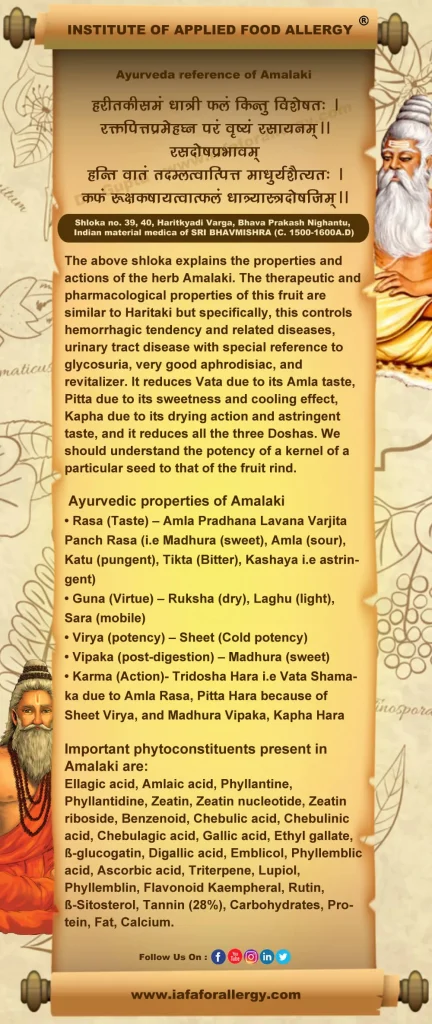
Scientific Classification of Amalaki
| Kingdom | Plantae |
| Class | Dicotyledons |
| Subclass | Monochlamydeae |
| Series | Curvembryae |
| Order | Unisexual |
| Family | Euphorbiaceae |
| Genus | Emblica |
| Species | officinalis |
Classification of Amalaki as per Charaka and Sushruta
- Charaka: Kusthaghana Mahakshaya, Kasahara Mahakshaya, Virechnopaga Mahakshaya, Jwaraghana Mahakshaya, Vayasthapana Mahakshaya
- Sushruta: Parushakadi gana, Amalakyadi gana, Triphala
Amalaki’s Description in Brihtrayi
| Charaka | Shusruta | Vagbhata
(Ashtang Hridya) |
| C. S. Su. 2/ 25, 30 | S. S. Su. 19/ 33 | A. H. Su. 6/ 156 |
| C. S. Su. 4/ 31, 24, 36, 39 | S. S. Su. 20/ 4 | A. H. Su. 8/ 42 |
| C. S. Su. 5/ 9 | S. S. Su. 38/ 53, 55, 59 | A. H. Su. 10/ 34 |
| C. S. Su. 7/ 60 | S. S. Su. 42/ 18 | A. H. Su. 14/ 24 |
| C. S. Su. 13/ 93 | S. S. Su. 44/ 54, 70 | A. H. Chi. 1/ 30, 31, 33, 56, 69, 76, 90 |
| C. S. Su. 15/ 6 | S. S. Su. 46/ 139, 143, 206, 334, 375 | A. H. Chi. 2/ 15 |
| C. S. Su. 21/ 22, 25 | S. S. Chi. 5/ 10, 12 | A. H. Chi. 3/ 60, 79 |
| C. S. Su. 23/ 37 | S. S. Chi. 6/ 13 | A. H. Chi. 4/ 42 |
| C. S. Su. 25/ 39, 40 | S. S. Chi. 10/ 13, 14 | A. H. Chi. 5/ 11, 44 |
| C. S. Su. 26/ 71, 72, 112 | S. S. Chi. 11/ 7, 11 | A. H. Chi. 7/ 22 |
| C. S. Su. 27/ 3, 144, 277 | S. S. Chi. 12/ 10 | A. H. Chi. 8/ 70 |
| C. S. Vi. 7/ 17, 22 | S. S. Chi. 24/ 15, 99 | A. H. Chi. 12/ 7, 8 |
| C. S. Vi. 8/ 144, 147 | S. S. Chi. 26/ 24 | A. H. Chi. 14/ 65, 89 |
| C. S. Chi. 1. 1/ 24, 34, 35, 39, 56, 63, 64, 73, 74, 75 | S. S. Chi. 27/ 7, 8, 11 | A. H. Chi. 16/ 32, 41 |
| C. S. Chi. 1. 2/ 4, 7, 8, 10 | S. S. Chi. 28/ 3, 6 | A. H. Chi. 18/ 5 |
| C. S. Chi. 1. 3/ 2, 9-13, 16, 40 | S. S. Ka. 5/ 78 | A. H. Chi. 19/ 10, 31, 46 |
| C. S. Chi. 1. 4/ 18 | S. S. Ka. 6/ 3 | A. H. Ka. 2/ 21 |
| C. S. Chi. 2. 1/ 28 | S. S. U. 11/ 15 | A. H. U. 5/ 8, 42 |
| C. S. Chi. 3/ 184, 185, 187, 202, 208, 219, 225, 230 | S. S. U. 12/ 49 | A. H. U. 11/ 2, 40 |
| C. S. Chi. 4/ 34, 56, 78 | S. S. U. 15/ 14 | A. H. U. 13/ 7, 15, 43, 44 |
| C. S. Chi. 5/ 119, 121, 123, 133 | S. S. U. 17/ 9, 22, 48, 49, 93 | A. H. U. 14/ 20 |
| C. S. Chi. 6/ 25, 29, 35, 47 | S. S. U. 21/ 46 | A. H. U. 16/ 43 |
| C. S. Chi. 8/ 66, 100, 136 | S. S. U. 39/ 137, 197, 221, 247, 279, 298, 304 | A. H. U. 24/ 40 |
| C. S. Chi. 10/ 29 | S. S. U. 41/ 50 | A. H. U. 28/ 38 |
| C. S. Chi. 11/ 65 | S. S. U. 44/ 25, 36, 37 | A. H. U. 34/ 51 |
| C. S. Chi. 14/ 138, 148, 154, 158 | S. S. U. 48/ 17 | A. H. U. 39/ 11, 16, 24, 28, 30, 36, 80, 159, 160 |
| C. S. Chi. 15/ 20, 152 | S. S. U. 49/ 19, 33 | |
| C. S. Chi. 16/ 57, 114, 134 | S. S. U. 50/ 27 | |
| C. S. Chi. 17/ 128 | S. S. U. 51/ 46 | |
| C. S. Chi. 18/ 92, 135, 184 | S. S. U. 52/ 15, 33, 35, 37 | |
| C. S. Chi. 21/ 53, 60, 66, 108, 111, 112 | S. S. U. 53/ 11 | |
| C. S. Chi. 22/ 35 | S. S. U. 54/ 31 | |
| C. S. Chi. 24/ 138, 139, 181 | S. S. U. 57/ 9 | |
| C. S. Chi. 26/ 52, 274, 276 | S. S. U. 58/ 37, 40, 63 | |
| C. S. Chi. 29/ 97, 98 | S. S. U. 60/ 40 | |
| C. S. Chi. 30/ 77, 115, 116, 256 | ||
| C. S. Ka. 1/ 13, 16 | ||
| C. S. Ka. 7/ 45, 63, 65 | ||
| C. S. Ka. 8/ 9 | ||
| C. S. Ka. 9/ 5 | ||
| C. S. Ka. 10/ 10, 18 | ||
| C. S. Si. 12/ 54, 55 |
External Morphology of Amalaki
A deciduous small or middle-sized tree with a crooked trunk and spreading branches. Branchlets are glabrous or finely pubescent, 10-20 cm long, and often deciduous.
- Leaves: Subsessile, 1-13 cm long, 2.5-3 mm wide, closely set along the branchlets, light green, glabrous, narrowly linear, obtuse, having the appearance of pinnate leaves, stipules ovate, finely acute.
- Flower: Greenish-yellow, in axillary fascicles on the leaf-bearing branchlets.
- Male flowers: Numerous, on short slender pedicels, sepals 6, oblong, obtuse. Anthers 3 on a short central column.
- Female flowers: Few, subsessile, ovary 3-celled.
- Fruit: 1-1.5 cm diameter, fleshy, globose, with 6 obscure vertical furrows, pale yellow of three 2-seeded crustaceous cocci.
- Fresh Amalaki Fruit: They are globular, fleshy, smooth, six-striated of a yellowish-green color, and sometimes as long as walnut. They contain an obovate-obtusely triangular, 6-celled nut, each cell of which contains two triangular seeds. The taste of fresh fruit pulp is acid, astringent, and somewhat acrid.
- Dry Amalaki Fruit: The dried fruits are of the size of a cobnut, sub-hexagonal, wrinkled, and of a grey-black color if they are collected from plants in the immature stage.
- Seeds: 6, trigonous.
Flowering and Fruiting Time of Amalaki
Autumn to the spring season; February-March
Varieties / Types of Amalaki
According to Raja Nighantu
Amalaka, Kshudra Amalaka or
- Vanya- Small and hard.
- Gramya- Big, soft, and fleshy.
Cultivate varieties of Amalaki:
- Krishana
- Amrit
- Neelam
- Kanchan
Distribution of Amalaki
It is found throughout India, common in the forest mixed deciduous of India ascending to 1350 meters in hilly regions. It is often planted in gardens and cultivated on a small or large scale being under cultivated practices suitable to certain regions, for the commercial fruit production. Trees occur commonly in tropical and subtropical regions in the country extending to various States.
The Useful Part of Amalaki
Fruit
Important Phytoconstituent of Amalaki
- Fruit- Ellagic acid, Amlaic acid, Phyllantine, Phyllantidine, Zeatin, Zeatin nucleotide, Zeatin riboside, Benzenoid, Chebulic acid, Chebulinic acid, Chebulagic acid, Gallic acid, Ethyl gallate, ß-glucogatin, Digallic acid, Emblicol, Phyllemblic acid, Ascorbic acid, Triterpene, Lupiol, Phyllemblin, Flavonoid Kaempheral, Rutin, ß-Sitosterol, Tannin (28%), Carbohydrates, Protein, Fat, Calcium,
- Bark- Tannin (10-20%)
- Leaves- Tannin (22%)
- Rich source of Vit. C. – 600 mg/ 100 g.
Recent Research on Amalaki
- Anti-bacterial
- Antifungal
- Antioxidant
- Insecticidal
- Larvicidal
- Radioprotective
- Antidepressant
- Immunomodulatory
- Anti-inflammatory
- Cytotoxic
- Hypoglycemic
- Hepatoprotective
- Anti- cancerous
- Anti- mutagenic
- Wound-healing properties
- Cardioprotective
- Memory enhancer
Toxicology
- Active crude alcoholic extract of the plant was assayed for cellular toxicity to fresh sheep erythrocytes and found to have no cellular toxicity.
Rasa-Panchaka (Properties) of Amalaki
| Rasa (Taste) | Amla Pradhana Lavana Varjita Panch Rasa (i.e Madhura (sweet), Amla (sour), Katu (pungent), Tikta (Bitter), Kashaya i.e astringent) |
| Guna (Virtue) | Laghu (light), Ruksha (dry), Sara (mobility) |
| Virya (potency) | Sheet (Cold potency) |
| Vipaka (post-digestion) | Madhura (sweet) |
| Dosha Karma (action on Dosha) | Tridosha Hara i.e Vata Shamaka due to Amla Rasa, Pitta Hara because of Sheet Virya and Madhura Vipaka, Kapha Hara because of Ruksha Guna and Kashaya Rasa |
*Kshudra Amalaki (Kasthadhari Phala) has Kashaya, Katu Rasa, and Sheeta Virya.
Prayogarha Vyadhi (Therapeutic Indication) of Amalaki
- Rasayana
- Parmeha
- Jwara
- Raktapitta
- Pandu Roga
- Kamala
- Shukra Dourbalya
- Daha
- Chardi
- Bhagna
- Shopha
- Kesha Vikara
Aamyik Prayog (Therapeutic Uses) of Amalaki
- Jvara (Fever)
- The juice of Amalaki fruits fried with ghee alleviates fever.(Charaka Samhita Chiktsa Sthana. 3/ 230)
- The patient with fever, in case of loss of sweat and sleep accompanied by excessive thirst, should take liquid gruel processed with Sunthi and Amalaki added with sugar and fried with ghee. It alleviates fever. (Charaka Samhita Chikitsa Sthana. 3/ 187)
- Aruchi (Loss of appetite): The Amalaki fruits are roasted on a charcoal fire, added with Ghee, Jirka, and salt, and fumigated with Asafetida. They stimulate digestive fire. (Kshemakutuhala. 8/ 64, 11/ 27)
- Arsha (Piles):
- Phala Arishta. (Charaka Samhita Chikitsa Sthana. 14/ 148-52)
- Kanak Arishta. (Charaka Samhita Chikitsa Sthana 14/ 158-68)
- Khada (a dietary preparation) made of Kaashmarya and Amalaki is taken with a supernatant fatty layer of curd that controls bleeding piles. (Charaka Samhita Chikitsa Sthana. 14/ 202)
- A regimen of buttermilk with Amalaki, Guduchi, etc. is prescribed in piles. (Susruta Samhita Chikitsa Sthana. 6/ 13)
- Krimi Roga (Worms): The juice of Amalaki or decoction of Bhibhitaki or Haritaki mixed with honey is useful as Anupana. (Susrutra Samhita Uttar Tantra. 54/ 31)
- Pandu (Anaemia):
- The juice of Amalaki and sugarcane in the form of Mantha (Churned drink) is beneficial in case of anemia. (Sushruta Samhita Uttara Tantra. 44/ 8)
- One should take the powder of Amalaki with honey. (Sushruta Samhita Uttar tantra. 44/ 27)
- Kamala (Jaundice):
- Dhatryavaleha. (Charaka Samhita Chikitsa Sthana. 16/ 100, 101)
- Dhatryarista. (Charaka Samhita Chikitsa Sthana. 16/ 111- 113)
- The juice of Mridwika (grapes) and Amalaki is useful in drink and food in case of jaundice. (Charaka Samhita Chikitsa Sthana. 16/ 114)
- Rakta Pitta (Intrinsic hemorrhage):
- Amalaki fruits mixed with plenty of honey and sugar should be used as a purgative. The juice is particularly beneficial in Rakta Pitta. (Charaka Samhita Chikitsa Sthana. 4/ 57-58)
- A fine paste of Amalaki fried with ghee is applied to the head. It cures epistaxis instantaneously. (Vrinda Madhava. 9/ 30, Sharanghdhara Samhita. 3/ 11.61)
- Swara Bheda (Hoarseness of voice): In case of hoarseness of voice, one should take Amalaki fruits with milk. (Raja Amarttanda. 10/ 3)
- Hikka (Hiccough): Juice of Amalaki and Kapittha mixed with Pippali (powder) and honey checks hiccough. (Charaka Samhita Chiktsa Sthana. 17/ 135)
- Kasa (Cough): The powder of Amalaki cooked with milk and added with ghee should be taken in a cough. (Shusruta Samhita Uttara Tantra. 52/ 36)
- Murcha (Fainting):
- Ghee cooked with a decoction of Haritaki or juice of Amalaki alleviates fainting. (Sushruta Samhita Uttara Tantra. 46/ 19)
- Steamed fruits of Amalaki should be pounded and mixed with Draksha and Shunthi and taken with honey. It pacifies fainting, bronchial asthma, and cough. (Vangasena Murcha. 35, Bhava Prakasha Samhita Chikitsa Sthana. 1/ 562)
- Hridya Vikara (heart disease): Chyavanaprasa, Agastya Leha, and Brahma Rasayana (made of) Amalaki is useful in diseases of the heart. (Charaka Samhita Chiktsa Sthana. 26/ 99)
- Chardi (Vomiting)
- In vomiting, a cold soup of green gram mixed with Amalaki juice should be taken. (Ashtanga Sangreha Chiktsa Sthana. 8/ 15)
- Amalaki fruits, Draksa, and Sarkara 40 gm should be pounded and mixed with honey 40 gm and water 160 ml. All this should be strained by cloth and taken. It alleviates vomiting caused by Tridosa. (Vangsena. Chardi. 37, Bhava Prakasha Samhita Chiktsa Sthana. 17/ 20)
- Trishna (Thirst): In the abnormal taste of the mouth, gargles should be used of sours and powder of Amalaki. (Sushruta Samhita Uttara tantra. 48/ 17)
- Daha (Burning sensation): Powder of Amalaki is impregnated with sugarcane juice twenty-one times and taken with milk added with sugar in the morning. It alleviates severe internal burning sensation. (Siddha Bhaishjya Manni Mala. 4/ 473)
- Amlapitta (Acid peptic disease): Powder consisting of Amalaki, Shatavari, and sugar all equal is mixed with an equal quantity of honey and taken with milk or ghee. It alleviates senility and promotes vision and vitality. It is known as Chatuhsama. (Vangasena Amlapitta. 49)
- Udavartta (due to urinary obstruction): An upward movement of Vayu, juice of Amalaki mixed with water should be taken for three days. (Sushruta Samhita Uttara Tantra. 55/ 22)
- Udara Shool (Abdominal pain):
- In pain caused by Pitta (hyperacidity) Amalaki powder mixed with honey should be taken. Juice of Amalaki or Vidari Kanda mixed with the juice of Trayamana and Draksha and added with sugar alleviates pain caused by Pitta instantaneously. (Vrinda Madhava. 26/ 25-26
- In Parinamasula, the powder of Amalaki fruit mixed with Lauha Bhasma or Madhuyasti powder should be taken with honey. (Vangsena Parinamasula. 95, Bhava Prakasha Samhita Chiktsa Sthana. 30/ 78)
- Kustha (Leprosy):
- One who takes powder of Amalaki and Nimba leaves in the morning regularly is freed from leprosy. (Raja Amrittanda. 8/ 1)
- In vitiligo, the decoction of Amalaki and Khadira mixed with seeds of Bakuci should be taken. It destroys the disorder quickly. (Vrinda Madhava. 51/ 34)
- Vatarakta (Gout): One should administer the decoction of Amalaki and Haridra sweetened with honey to alleviate the Vatarakta. (Charaka Samhita Chiktsa Sthana. 5/ 10)
- Visarpa (Erysipelas): In erysipelas, Amalaki juice mixed with ghee should be given. In case there is constipation, Trivrit powder should be added to this. (Charaka Samhita Chiktsa Sthana. 21/ 67, Vrinda Madhava. 54/ 3)
- Jalakagardabha (acute spreading inflammation): In Jalakagardabha, regular use of Amalaki and cold pastes (Sheeta lepa) are recommended. (Charaka Samhita Chiktsa Sthana. 12/ 100, Ashtanga Hridya Uttara Tantra. 32/ 6, Ashtanga Sangreha Uttara Tantra. 37/ 8)
- Masurika (Pox): In case of pox associated with the wound in the mouth and throat one should take the decoction of Amalaki fruits and Madhuka added with honey as a gargle. (Bhava Prakasha Samhita Chiktisa Sthana. 60/ 50)
- Vyanga (freckle): Tender fruits of Amalaki should be kept in cow’s urine for a week and then pounded with goat’s milk. It is applied as a paste on the face. (Ashtanga Sangreha Uttara Tantra. 37/ 24)
- Palitya (Greying of hairs): One who applies the paste of Mandura, Amalaki, and Japa flowers on hairs before taking bath is freed from the disease. (Vrinda Madhava. 57/ 91)
- Prameha (Diabetes):
- Amalaki and Haridra are the best remedies for Prameha. (Ashtanga Hridya Uttara tantra. 40/ 48).
- The patient of Prameha, after unction, emesis, purgation, and a non-unctuous enema should be given the juice of Amalaki mixed with Haridra and honey. (Vrinda Madhava. 35/ 16, Sushruta Samhita Chiktsa Sthana. 11/ 8)
- Mutra Vega Vidharana (Suppression of urine):
- On taking 160 ml, juice of Amalaki mixed with honey one is relieved of the urinary trouble. (Sushruta Samhita Uttara tantra. 58/ 39-40)
- One should take Ela with the juice of Amalaki. (Susruta Samhita Uttara Tantra. 58/ 41)
- Amalaki taken with jaggery is saturating, promotes semen, and alleviates exertion, Raktapitta, burning sensation, colic, and dysuria. (Vrinda Madhava. 32/ 8)
- One should take the juice of Amalaki or sugarcane mixed with honey in case of dysuria or hematuria. (Bhava Prakasha Samhita Chiktsa Sthana. 35/ 32)
- Netra Vikara (Eye diseases):
- Juice coming out of the mature fruit of Amalaki staying on the plant after piercing with the nail alleviates numerous diseases of the eye caused by the aggravation of Vata, Pitta, and Kapha. (Raja Amrittanda. 3/ 10)
- Semisolid extract of Amalaka and Rasanjana mixed with honey alleviates diseases of the eye caused by Pitta and Vata, defects of vision, and Patal. (Charaka Samhita Chikitsa Sthana. 26/ 250, Vrinda Madhava. 61/ 172)
- Similar preparation made by boiling leaves and fruits of Amalaki pacifies acute conjunctivitis by filling the eye. (Vanga Sena Netraroga. 34)
- Swasthsya Swasthya Rakshnam (As preventive measure): Healthy person should wash his mouth, face, and eyes with a decoction of Amalaki or cold water to prevent disorders of the face, dryness of mouth, and diseases caused by Rakta and Pitta. (Sushruta Samhita Chiktsa Sthana. 24/ 15, 16)
- For promoting intellect (Medhya): To promote intellect and prevent senility one should take powder of sesamum and Amalaki mixed with honey and ghee in the morning for a month. (Vaidya Manorama. 20/ 15, 20/ 5)
- Rasayana (Rejuvenator):
- Amalaki- Rasayana. (Charaka Samhita Chiktsa Sthana. 1. 2/ 8, 1. 1/ 58 – 74, 1. 2/ 4- 10, 1. 3/ 9- 13)
- One should take powder of Amalaki mixed with gold (Bhasma) and honey. It promotes longevity. (Sushruta Samhita Chikitsa Sthana. 28/ 20)
- For maintaining youthfulness (and preventing senility) Amalaki is the best one. (Ashtanga Hridya Uttara Tantra. 40/ 56)
- Senility in persons goes away who take Amalaki juice mixed with honey, sugar, and ghee while keeping on a wholesome diet. (Ashtanga Hridya Uttara Tantra. 39/ 149)
- One who takes powder of Amalaki, Vidanga and Asana mixed with oil, ghee, honey, and Lauhabhasma does not lose youthfulness. (Ashtanga Hridya Uttara Tantra. 39/ 150)
- Those who take Amalaka and Tila mixed with Bhringaraja regularly do not suffer from disease and senility. (Vrinda Madhava. 69/ 11)
- Amalaki- Rasayana (Vrinda Madhava. 69/ 19)
- Vajikarana (As aphrodisiac): Powder of Amalaki impregnated with the juice of Amalaki itself mixed with sugar, honey and ghee should be taken followed by intake of milk. By this, even the old are stimulated like the young. (Sushruta Samhita Chiktsa Sthana. 26/ 24, Vrinda Madhava. 70/ 8-9)
- Pradara (Leuccorhea):
- The paste of Amalaki seeds mixed with sugar and honey should be taken with water, or powder or juice of Amalaki should be administered with honey. (Charaka Samhita Chikitsa Sthana. 30/ 117)
- The paste of Amalaki seeds mixed with honey and sugar should be taken with water. It alleviates leucorrhoea in three days. (Bhava Prakasha Samhita Chiktsa Sthana. 69/ 10)
- Amalaki seeds are taken with rice water to alleviate menometrorrhagia or Amalaki pounded with Udumbara decoction and taken with cold water does the same. (Vaidya Manorma. 2/ 9)
- Somaroga (Excessive urination): Ripe banana fruit, Amalaka juice, honey, and sugar- all mixed should be taken to control the Somaroga (excessive urination). (Gada Nigreha. 6. 1. 69)
- Yoni Daha (Burning sensation in female genitals): In such a case, the woman should take Amalaki juice mixed with sugar. (Bhava Prakasha Samhita Chiktsa. 70/ 41)
- Bala Roga (Children’s disease): In Vicchi disease of children 320 gm of Amalaki powder is impregnated with cow’s urine seven times and dried in the sun. This applied as paste alleviates the disease. (Vangasena. Balrog. 122)
- Udarda (Urticaria):
- One should use Pippali- Vardhamana or garlic or Madhuka mixed with sugar or Amalaka mixed with jaggery. (Vrinda Madhava. 52-53)
- One should regularly use the leaves of Nimba mixed with Amalaki along with ghee. It alleviates eruptions, allergic manifestations, wounds, itching, and intrinsic hemorrhage. (Vrinda Madhava. 52/ 8)
Matra (Therapeutic Administration and Dosage) of Amalaki
- Phala Churna (Fruit powder): 3- 10 gram
- Kashaya (decoction): 30- 100ml
- Swarasa (juice): 10 – 20ml

Have A Health Issue?
Consult Online
- Dr. Sahil Gupta (B.A.M.S., M.H.A.)
Ayurvedic Allergy Specialist
CEO & Founder of IAFA®
Classical Reference of Amalaki
Kaiydeva Nighantu, Aushadhiadi Varga, 238
तद्वद धात्री स्वेदमेदोहराम्ला शुक्रला हिमा।
भग्न संधान कृत केश्या पिपासाकफपित्तहत्।।
Kaiydeva Nighantu, Aushadhiadi Varga, 239- 240
फलमज्जा
तन्मज्जा तुवर: स्वादुस्तृट्छर्दनिलपित्तहा।
फलम्
हन्ति वातं तदम्लत्वात् पित्त माधुर्यशैत्यतः।।
कफं रूक्षकषायत्वात् फलेभ्यो अभ्यधिकं मतम् ।
चक्षुष्य॑ सर्वदोष्घ्नं वृष्यमामलकी फलम्।।
Raja Nighantu, Amraadi Varga, 158
आमलकं कषायाम्लं मधुरं शिशिरं लघु।
दाहपित्तवमीमेहे शोफघ्नं च रसायनम्।।
Raja Nighantu, Amraadi Varga, 159
कटु मधुर कषायं किञ्चित् अम्लं कफघ्नं
रुचिकरमतिशीतं हन्ति पित्तास्रतापम् ।
प्रशमनममृत्ताभं चामलक्या: फल स्यात्।।
Bhava Prakasha Nighantu, Haritkyadi Varga, 39
हरीतकीसमं धात्री फलं किन्तु विशेषत: ।
रक्तपित्तप्रमेहघ्न परं वृष्यं रसायनम्।।
Bhava Prakasha Nighantu, Haritkyadi Varga, 40
रसदोषप्रभावम्
हन्ति वातं तदम्लत्वात्पित्त माधुर्यशैत्यत: ।
कफं रूक्षकषायत्वात्फलं धात्र्यास्त्रदोषजित्।।
Chakradutta, Vrishyadhikara, 66- 4
वृष्यामलकचूर्णम्
एषमामलकं चूर्णं स्वरसेनैव भावितम्।
शर्करा मधु सर्पिर्भि युक्ते लीढ्वा पयः पिबेत्।।
एतेना शोर्तिवर्षो अपि युवेव परिहष्यते।
Chakradutta, Rasayanaadhikara, 23
धात्रीचूर्णरसायनम्
धात्रीचूर्णस्य कंसं स्वरसपरिंगतं क्षौद्रसार्पि: समांशं,
कृष्णा मानीसिताष्टप्रसृतभुत्मिदं स्थापित॑ भस्मराशौ ।
वर्षान्ते तत् समश्ननूभवति विपलितो रूपवर्णप्रभावै
निंव्याधिबुद्धिमेधास्मृतिबल वयनस्थैर्यसर्षपसत्वैरुपेत: ।।
Bhava Prakasha Nighnatu, Haritkyadi Varga, 47
फलानुसार्येणमज्जागुणानि ( सामान्य सिद्धान्त )
यस्य यस्य फलस्येह वीर्य भवति यादृशम् ।
तस्य तस्यैव वीर्येण मज्जानमपि निर्दिशेत्।।
Charaka Samhita, Sutra Sthana. 27
Charaka Samhita, Chikitsa Sthana. 3
तान् गुणांस्तानि कर्माणि विद्यादामलकीष्वपि ।
यान्युक्तानि हरीतक्या वीर्यस्य तु विपर्यय:।।
Shusruta Samhita, Sutra Sthana. 46
अम्लं समुधरं तिक्त॑ कषायं कटुकं रसम्।
चक्षुष्यं सर्व दोषघ्नं वृष्यमामलकी फलम्।।
हन्ति वातं तदम्लत्वात पित्तं माधुर्यशैत्यत: ।
कफ रूक्षकषायत्वात्फलेभ्यो अभ्यधिकं च यत।।
Charaka Samhita, Chikitsa Sthana. 1- 1/ 37
हरीतकीसमगुणा:
अतश्चामृतकल्यानि विद्यात् कर्म भिरी दृशे ।
हरीतकीनां शस्यानि भिषगामलकस्य च।।
तान् गुणांस्तानि कर्माणि विद्यादामलकीवपि
तान्युक्तानि हरीतक्या वीर्यस्य तु विपर्यय:।।
Charaka Samhita, Chikitsa Sthana. 1-1/ 8
रसायने आमलकचूर्णम्
आमलक चूरन आढक मेकविंशतिरात्रमामलकस्वरसपरिपीतं पीत ||
मधुघृताढकभ्या द्वाभ्यामेकीकृत्तमष्ट भागं पिप्पलीकं शर्करा चूर्ण
चतुर्भागसंप्रयुक्ते घृढतंभाजनस्य प्रावृषिः भस्म रात्रौ निदध्यात।
तद वर्षान्ते सात्म्यपथ्याशी प्रयोजयेत: अस्य प्रयोगाद वर्ष
शतमजरमायुस्तिष्ठतीति समानं पूर्वेण।
Charaka Samhita Sutra Sthana. 27
आमलक वय:स्थापनानम् ( श्रेष्ठम)।
Chakradutta, Netra Roga Chikitsa, 59- 39
तरुस्थविद्धामलकरस: सर्वाक्षिरोगनुत् ।
पुराणं सर्वथा सर्प: सर्व नेत्रामयपहम् ॥
Chakradutta , Asrigdara Chikitsa, 3-4
कफज (श्वेत ) प्रदररोगे धात्री प्रयोग:
जलेनामलकाबीजकल्कं वा ससितामधु।
आमलकया मधुद्रवम्।।
Bhava Parkasha Samhita, Rakta Pitta Adhikaram, 8- 46
नासागतरक्तपित्ते
नासाप्रवृत्त रुधिरं घृतभ्रष्ठं भुयणपिष्टमामलकम् ।
सेतुरिव तोयवेग रुणाद्धि मूर्हिन प्रलेपेत्।।
Bhava Parkasha Samhita, Amla Pitta Adhikaram, 10- 19
अम्लपित्त
हन्त्यम्लपित्ततमनारुचिदाहमोहखालित्यमोहशिशिर व्रणशुक्रदोषान्।
भुक्त्वा नर: सततमामलकी रसेन वृद्धो अप्यनेन हि भवेत्तरुणो रिरंसु:।।
Bhava Parkasha Samhita, Shoola Adhikaram, 30- 73
अन्नद्रवशूले
धात्रीफलभवं चूर्णमयश्च चूर्ण समन्वितम्।
यष्टि चूर्णन वा युक्तं लिह्या क्षोद्रेंण तद।
Bhava Parkasha Samhita, Gulma Adhikaram, 32- 48
रक्तगुल्मे धात्रीरसम्
पीतो धात्रीरसो मरिचैश्च अस्रगुल्मनुत् ।
Bhava Parkasha Samhita, Mutra Kricha Adhikaram, 35- 44
मूत्रकृच्छे धात्रीरसम्
गुडाममलकं वृष्यं श्रमघ्नम तर्पणं प्रियम् ।
पित्तासृग्दाहशूलघ्न मूत्रकृच्छ निवारनम् ।
Bhava Parkasha Samhita, Kustha Roga Adhikaram, 54= 132
चर्मदले
सलिलेन तु शुष्काणि घृष्टवा धात्रीफलानिय ।
कराभ्यां सुखमाप्रोति नरश्चर्म दलान्वित: ॥
Bhava Parkasha Samhita, Soma Roga Adhikaram, 69- 10
सोमरोगे
जलेनामलकीबीजकल्कं समधुशर्करम् ।
पिबेहिनत्रयेणैव श्रेतप्रदरनाशनम् ॥
Bhava Parkasha Samhita, Yoni Daha Adhikaram, 70- 41
योनिदाहे
धात्रीरसं सिता युक्तं योनिदाहे पिबेत्सदा ।
Chakradutta Jvara Chikitsa, 1- 94
दाहशान्त्यर्थ धात्रीप्रलेप:
घृत भृष्ट अम्लपिष्टा धात्री लेपाच्च दाहनुत् ।
Chakradutta Chardi Chikitsa, 15- 21
त्रिदोषजन्यवमने धात्रीफलादिपानकम् ।
Chakradutta 27/ 60- 65
परिणामशूलचिकित्सायां धात्रीलौहम् ।
Chakradutta Chardi Chikitsa, 15- 20
प्रबलवमने धात्रीरसादियोग:
धात्र्या रस: कपित्थस्य पिप्पलीमरिचान्वित: ।
क्षौद्रेण युक्त: शमयेल्लेहोयं छर्दिमुल्वणम् ॥
Charaka Samhita, Chikitsa Sthana, 1.1/ 5-6
रसायने आमलकघृतम्
बृहच्छरीरं गिरिसारसारं स्थिरेन्द्रिय यातिबलेन्द्रियं च ।
अधृष्यमन्यैरतिकान्तरूप प्रशस्तिपूजासुखचित्तभाक् च ।
भवत्यपत्य विपुलं स्थिरं व समश्रतो योगमिमं नरस्य ॥
Chakradutta 26/ 51- 58
शूलचिकित्सायां धात्री लौहम्।
Charaka Samhita Chikitsa Sthana, 1. 1/ 7
रसायने आमलकावलेह:
आमलकसहस्त्रं पिप्पली सहस्त्रं संप्रयुक्त पलाशतरुण क्षारोदकोत्तरं तिष्ठेत, तदनुगतक्षारोदकमनात शुष्कमनास्थि
चूर्णकृत चतुर्शुणाभ्यां मधुसर्पिभ्यां संनीय शर्कराचूर्णचतुर्भागसंप्रयुक्त घृतभाजनस्थ॑ षष्मासान् स्थापयेदन्तभूमे: ।
तस्योत्तरकालमग्निबलसमां मात्रां खादेत पौर्वाहिंक: प्रयोगो नापराहिक: सात्म्यापेक्षश्च आहारविधि: । अस्य प्रयोगाद वर्ष शतम जरं वयस्तिष्ठतीति
समान पूर्वेण ।
Charaka Samhita Chikitsa Sthana, 16- 100, 101, 111- 114
पाण्डरोगे धात्र्यवलेह: पाण्डु रोगे धात्र्यरिष्ट:।
Charaka Samhita Chikitsa Sthana, 30/ 116
श्रेतप्रदरे
जलेनामलकीबीजं कल्कं वा ससितामधुम् ।
ज्वर (श्वास-कास-मूर्छा-अरुचिसहित) चतुर अंगुल अवलेह
स्विन्नामलकं पिष्ट्वा द्राक्षया सह मेलयेत्।
विश्वभेषजसंयुक्त मधुना सह लेहयेत् ।
तेनास्य शाम्यति श्वास: कासो मूर्छा अरुचिस्तथा।।
Chakradutta, 55- 95
इन्द्र लुप्ते धात्र्यादि लेप:
धात्र्याम्रमज्जलेपात् स्यात् स्थिरता स्निघ्धकेशता |
इन्द्रलुप्ते शिरां विद्ध्वा शिलाकाशीसतुत्थकै:।।
Bhava Prakasha chikitsa, Jvaradhikara, 1- 40, 41
अतिसारे आमलकालवालम
कृत्वा आलवाल सुदृढ़म पिष्टेरामलकैर्मिषक।
आदरकस्य रसेनाशु पूरयेन्नाभिमण्डलम्।।
नदीवेगोपमं घोरं प्रबृद्धं दुद्धर नृणाम।
सद्यो अतीसारमजयं नाशयत्येष योगराट्।।
Chakradutta, 35- 21
प्रमेहरोगे धात्रीस्वरस:
सर्वमेहहरो धात्र्या रस: क्षौद्रनिशायुत: ।
Specific Formulation of Amalaki
- Amalaki Kashayam for Pittaja Gulma
- Amalaki Rasayana for Varya and Buddhi Vardhak
- Amalkya Avaleha for Pandu and Kamala
- Amalkyadi Kwatha for Sarva Jvara, Kapha Vikara
- Bhrangamalkadi Taila for Kesha Vikara, netra Roga
- Triphala Kwath for Jwara and Kasa
- Triphala Ghrita for Timira and Netra Roga
- Dhatrya Arishta for Pandu, Kamala and Hridroga.
Some other important formulation of Amalaki is: Chyavanprasha, Brahma Rasayana, Dhatryavleha, Aamlaka Ghrita, Dhatriphaladi Panakam, Amalaka Churna, Dhatri Pralepa, Chaturanga Avleha, Dhatri Rasadi Yoga.
Contraindication and Side Effects of Amalaki
- Amalaki exhibits a hypoglycemic effect, so patients with diabetes must take it under supervision if taking diabetes medication as it may lower blood glucose levels.
- Along with this Amalaki is rich in fibers, so may lead to some gastrointestinal issues in a few patients like bloating, diarrhea, stomachache, etc.
- Amalaki is possibly safe when used as medicine if taken 1000mg daily dosage for up to 6 months.
- Stay on the safe side and avoid the use of Amalaki during pregnancy and breastfeeding.
Suggestive Reading Regarding Amalaki
- Hasan, M. R., Islam, M. N., & Islam, M. R. (2016). Phytochemistry, pharmacological activities and traditional uses of Emblica officinalis: A review. International Current Pharmaceutical Journal, 5(2), 14–21. https://doi.org/10.3329/icpj.v5i2.26441
- Guruprasad, K. P., Dash, S., Shivakumar, M. B., Shetty, P. R., Raghu, K. S., Shamprasad, B. R., Udupi, V., Acharya, R. V., Vidya, P. B., Nayak, J., Mana, A. E., Moni, R., Sankaran, M. T., & Satyamoorthy, K. (2017). Influence of Amalaki Rasayana on telomerase activity and telomere length in human blood mononuclear cells. Journal of Ayurveda and integrative medicine, 8(2), 105–112. https://doi.org/10.1016/j.jaim.2017.01.007
- Kumar K.S., Bhowmik D., Dutta A., Yadav A.P., Paswan S., Srivastava S. Recent trends in potential traditional Indian herbs Emblica officinalis and its medicinal importance. J Pharmacogn Phytochem. 2012;1:18–28.
- Mayachiew P., Devahastin S. Antimicrobial and antioxidant activities of Indian gooseberry and galangal extracts. Leb Wiss Technol. 2008;41:1153–1159.
- Kumar, V., Aneesh, k.A., Kshemada, K. et al. Amalaki Rasayana, a traditional Indian drug enhances cardiac mitochondrial and contractile functions and improves cardiac function in rats with hypertrophy. Sci Rep 7, 8588 (2017). https://doi.org/10.1038/s41598-017-09225-x
- Sharma, *Kavitha, Sharma, P., Srivastav, R., Srivastava, A., & Sharma, D. (2017). PHARMACOLOGICAL STUDY OF AMALAKI WITH SPECIAL REFERENCE TO ITS ANTIMICROBIAL ACTION. International Journal of Ayurveda and Pharma Research, 5(5). Retrieved from https://ijapr.in/index.php/ijapr/article/view/675
- Jain, P. K., Das, D., Pandey, N., & Jain, P. (2016). Traditional Indian Herb Emblica Officinalis & Its Medicinal Importance. Innovare Journal of Ayurvedic Sciences, 4(4), 1–15. Retrieved from https://innovareacademics.in/journals/index.php/ijas/article/view/13607
- Srivasuki KP. Nutritional and health care benefits of Amla. J Pharmacognosy 2012;3(2):141-51.
- Pushpendra Kumar Jain, Debajyoti Das, Puneet Jain. Evaluating Hair Growth Activity of Herbal Hair Oil. Int J PharmTech Res 2016; 9(3):321-27.
- Rehman H, Yasin KA, Choudhary MA, Khaliq N, Rahman A, ChoudharyMI, Malik S. Studies on the chemical constituents of Phyllanthus emblica, Natural Product Research 2007; 21(9): 775-81.
- Jain SK, Khurdiya DS, Vitamin C enrichment of fruit juice based ready-to-serve beverages through the blending of Indian gooseberry (Emblica officinalisGaertn.) juice, Plant Foods for Human Nutrition 59(2), 2004, 63-6.
- Madhuri S, Pandey G, Verma KS. Antioxidant, immunomodulatory, and anticancer activities of Emblica officinalis an overview. Int Res J of Pharmacy 2011; 2(8):38-42.
- Zhang LZ, Zhao WH, Guo YJ, Tu GZ, Lin S, Xin LG. Studies on chemical constituents in fruits of Tibetan medicine.Phyllanthus emblica, Zhongguo Zhong Yao ZaZhi 2003;28(10):940-43.
References
- Agnivesha, Charaka, Dridhabala . In: Charaka Samhita, ed. Vaidya Jadavaji Trikamji Aacharya., editor. Varanasi: Chaukhamba Sanskrit Sansthan; 2009.
- Sushruta. In: Sushruta Samhita, Sutra Sthana, ed. Vaidya Jadavji Trikamji Acharya., editor. Varanasi: Choukhambha Orientalia; 2005.
- Vagbhata. In: Ashtanga Hrudaya, 9th ed. Anna Moreshwar Kunte, Krishnashastri Navarre, Harishastri, editors. Varanasi: Choukhambha Orientalia; 2005.
- Bhavamishra. In: Bhava Prakasha Nighantu,Hritkyadi Varga 11th ed. part 2. Brahma Shankara Mishra., editor. Varanasi: Choukhambha Bharati Academy; 2009.
- Bhavprakasha, commentary by Bulusu Sitaram, forwarded by K.C.Chunekar
- Sharma PV, Kaideva Nighantu. Aushadhi Varga. Chaukhamba Orientalia, Varanasi; 2006:
- Tripathi I., Raja Nighantu, Chandanadi, Aamradi Varga, Chaukhamba Krishnadas Academy; Varanasi; 2010
- Dr. Gyanendra Pandey, Dravyaguna Vigyana, reprint 2012, Chwkhamba Krishnadas Academy
- K.niteshwar Dravyagunavigyana, reprint 2017.
- Dr. J.L.N. Sastry and Dr. B.S. Sastry, Dravyaguna Vigyana, Chaukhambha Orientalia, Varanasi.
- Chakrapanidatta, Chakradatta with the vaidayaprabhahindi commentary by indradevatripathi, chaukambha sankritasansthan, varanai 2nd Edition, 1994.
- PC Sharma, MB Yelena, TJ Dennis, Database on medicinal plants used in Ayurveda, Vol-3, CCRAS, Dept. of ISM & H, Min. of Health & Family Welfare, Govt. of India, reprint 2005, p 16.
Ayurveda is an Indian system of medicine that is popular since ancient times. Dr. Gupta’s IAFA® has been conducting research studies to find out different phytoconstituents of herbs and their action in the body. Such knowledge acquired by our experts is used in the preparation of medicines and providing the treatment facilities safely and effectively. IAFA® is the provider of safe and effective treatment for a wide range of diseases, mainly allergic diseases all based on Ayurveda.
Was this Page Helpful?
Read More Articles
-
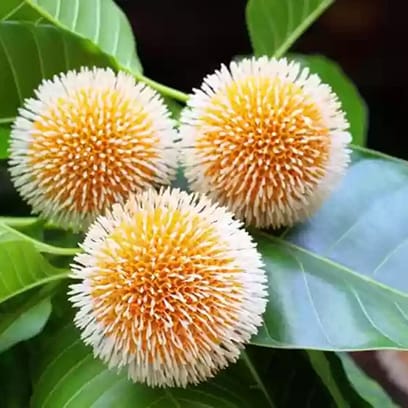
Kadamba (Neolamarckia cadamba)
Know about therapeutic uses, benefits and indications of Kadamba (Neolamarckia cadamba). It…
-
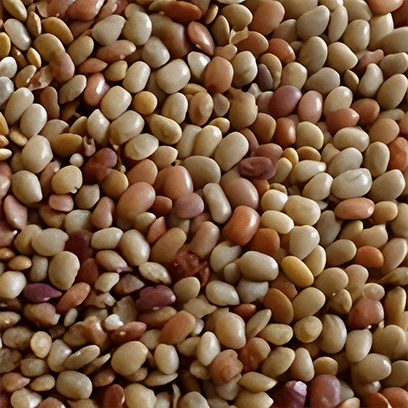
Kulattha (Dolichos biflorus)
Know about therapeutic uses, benefits and indications of Kulattha (Dolichos biflorus). It…
-
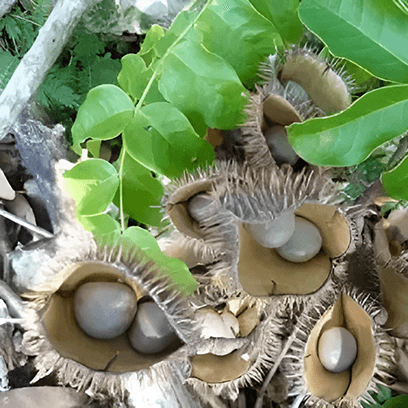
Latakaranja (Caesalpinia crista)
Know about therapeutic uses, benefits and indications of Latakaranja (Caesalpinia crista). It…

